Sprouse Family of Ragged Mountain, Albemarle County, Virginia
At that place is a direct and strong link between the word nigger and anti-blackness caricatures. Although nigger has been used to refer to any person of known African ancestry.2 it is usually directed against blacks who supposedly have certain negative characteristics. The Coon caricature, for example, portrays black men equally lazy, ignorant, and obsessively self-indulgent; these are likewise traits historically represented past the word nigger. The Brute caricature depicts black men every bit angry, physically strong, animalistic, and prone to wanton violence. This depiction is besides implied in the word nigger. The Tom and Mammy caricatures are often portrayed every bit kind, loving "friends" of whites. They are besides presented as intellectually childlike, physically unattractive, and neglectful of their biological families. These latter traits accept been associated with blacks, generally, and are implied in the give-and-take nigger. The give-and-take nigger was a autograph style of saying that blacks possessed the moral, intellectual, social, and physical characteristics of the Coon, Brute, Tom, Mammy, and other racial caricatures.
The etymology of nigger is frequently traced to the Latin niger, meaning blackness. The Latin niger became the noun negro (black person) in English, and simply the color blackness in Spanish and Portuguese. In Early Modern French niger became negre and, later, negress (black woman) was clearly a role of lexical history. One can compare to negre the derogatory nigger – and before English variants such as negar, neegar, neger, and niggor – which adult into a parallel lexico-semantic reality in English. It is probable that nigger is a phonetic spelling of the white Southern mispronunciation of Negro. Any its origins, by the early on 1800s it was firmly established as a denigrative epithet. Near two centuries later, it remains a main symbol of white racism.
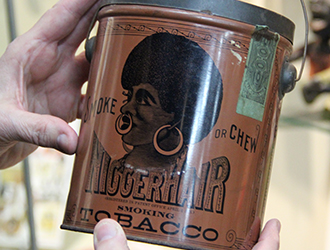
The give-and-take nigger carries with it much of the hatred and repulsion directed toward Africans and African Americans. Historically, nigger defined, limited, and mocked African Americans. It was a term of exclusion, a verbal justification for discrimination. Whether used equally a noun, verb, or describing word, it reinforced the stereotype of the lazy, stupid, dirty, worthless parasite. No other American ethnophaulism carried and so much purposeful venom, as the following representative listing suggests:
- Nigger, v. To clothing out, spoil or destroy.
- Niggerish, adj. Acting in an indolent and irresponsible manner.
- Niggerlipping, v. Wetting the end of a cigarette while smoking it.
- Niggerlover, n. Derogatory term aimed at whites lacking in the necessary loathing of blacks.
- Nigger luck, north. Uncommonly good luck, emphasis on undeserved.
- Nigger-flicker, north. A small knife or razor with one side heavily taped to preserve the user's fingers.
- Nigger heaven, due north. a designated place, usually the balcony, where blacks were forced to sit, for example, in an integrated movie house or church.
- Nigger knocker, due north. axe handle or weapon made from an axe handle.
- Nigger rich, adj, Deeply in debt just ostentatious.
- Nigger shooter, n. A slingshot.
- Nigger steak, n. a slice of liver or a cheap slice of meat.
- Nigger stick, n. police officeholder's baton.
- Nigger tip, n. leaving a small tip or no tip in a eatery.
- Nigger in the woodpile, northward. a concealed motive or unknown factor affecting a situation in an adverse style.
- Nigger work, due north. Demeaning, menial tasks.(Green, 1984, p. 190)
Nigger has been used to describe a nighttime shade of color (nigger-brown, nigger-blackness), the condition of whites who interacted with blacks (nigger-breaker, -dealer, -driver, -killer, -stealer, -worshipper, and -looking), and anything belonging to or associated with African Americans (nigger-infant, -boy, -girl, -mouth, -feet, -preacher, -task, -love, -civilization, -higher, -music, and so forth).4 Nigger is the ultimate American insult; it is used to offend other ethnic groups, as when Jews are called white-niggers; Arabs, sandniggers; or Japanese, yellowish-niggers.
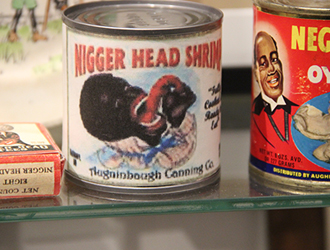
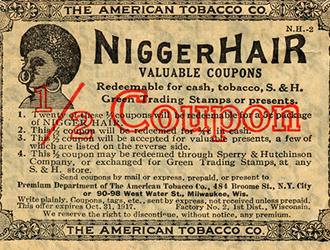
Both American slavery and the Jim Crow caste system which followed were undergirded past anti-blackness images. The negative portrayals of blacks were both reflected in and shaped by everyday material objects: toys, postcards, ashtrays, detergent boxes, fishing lures, children's books. These items, and countless others, portrayed blacks with jutting, darting eyes, burn-red and oversized lips, jet black skin, and either naked or poorly clothed. The majority of these objects did non employ the word nigger; however, many did. In 1874, the McLoughlin Brothers of New York manufactured a puzzle game called "Chopped Up Niggers." Beginning in 1878, the B. Leidersdory Company of Milwaukee, Wisconsin, produced NiggerHair Smoking Tobacco - several decades later on the name was changed to BiggerHair Smoking Tobacco. In 1917, the American Tobacco Company had a NiggerHair redemption promotion. NiggerHair coupons were redeemable for "cash, tobacco, S. & H. Green stamps, or presents."
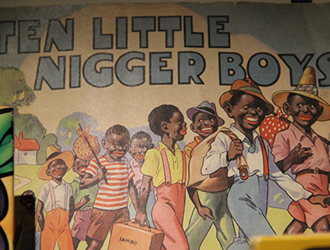
A 1916 mag advert, copyrighted by Morris & Bendien, showed a blackness child drinking ink. The explanation read, "Nigger Milk."
The J. Millhoff Company of England produced a series of cards (circa 1930s), which were widely distributed in the United States. One of the cards shows 10 small blackness dogs with the caption: "Ten Little Nigger Boys Went Out To Dine." This is the first line from the popular children'south story "The Ten Little Niggers."
- Ten Little Nigger Boys went out to dine;
- One choked his footling cocky, and then there were Nine.
- Nine Lilliputian Nigger Boys sabbatum up very late;
- One overslept himself, and and then there were Eight.
- Eight Piddling Nigger Boys traveling in Devon;
- One said he'd stay there, and then there were Seven.
- Seven Piffling Nigger Boys chopping upwardly sticks;
- One chopped himself in halves, and then there were 6.
- Six Little Nigger Boys playing with a hive;
- A Bumble-Bee stung i, and then there were V.
- Five Little Nigger Boys going in for Constabulary;
- One got in Chancery, and then there were Four.
- 4 Petty Nigger Boys going out to Sea;
- A Red Herring swallowed one, and then there were 3.
- Three Fiddling Nigger Boys walking in the Zoo;
- The large Bear hugged one, and and then at that place were Two;
- Two Footling Nigger Boys sitting in the Lord's day;
- One got frizzled up, and then there was Ane.
- One Little Nigger Male child living all alone;
- He got married, and so there were None.(Jolly Jingles, north.d.)
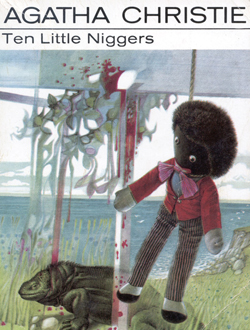
In 1939, Agatha Christie, the popular fiction author, published a novel called Ten Little Niggers. Later editions sometimes changed the name to Ten Little Indians, or And Then At that place Were None, merely as late equally 1978, copies of the book with the original title were being produced into the 1980s. It was non rare for sheet music produced in the starting time half of the 20th century to apply the discussion nigger on the cover. The Howley, Haviland Company of New York, produced sheet music for the songs "Hesitate Mr. Nigger, Hesitate," and "You'se Just A Little Nigger, Nevertheless You'se Mine, All Mine." The latter was billed every bit a children'southward lullaby.
Some small towns used nigger in their names, for example, Nigger Run Fork, Virginia. Nigger was a common name for darkly colored pets, especially dogs, cats, and horses. So-called "Jolly Nigger Banks," first made in the 1800s, were widely distributed equally belatedly as the 1960s. Another common particular - with many variants, produced on posters, postcards, and prints - is a picture show of a dozen black children rushing for a pond hole. The captions read, "Last One In'southward A Nigger."
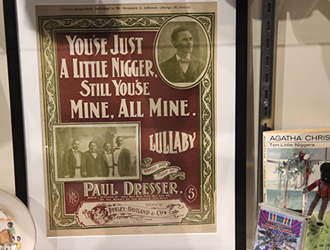
I of the about interesting and perplexing phenomena in American spoken communication is the use of nigger past African Americans. When used by blacks, nigger refers to the following: all blacks ("A nigger can't even go a interruption."); blackness men ("Sisters desire niggers to piece of work all day long."); blacks who bear in a stereotypical, and sometimes mythical, mode ("He's a lazy, expert-for-nothing nigger."); things ("This piece-of-shit automobile is such a nigger."); foes ("I'm ill and tired of those niggers bothering me!"); and friends ("Me and my niggers are tight.").
This concluding usage, as a term of endearment, is especially problematic. "Sup Niggah," has become an nearly universal greeting amongst immature urban blacks. When pressed, blacks who use nigger or its variants claim the following: information technology has to exist understood contextually; continual use of the word past blacks will brand it less offensive; it is non really the aforementioned word because whites are saying nigger (and niggers) only blacks are saying niggah (and niggaz); and, it is just a word and blacks should not be prisoners of the past or the ugly words which originated in the past. These arguments are not convincing. Blood brother (Brotha) and Sister (Sistha or Sista) are terms of endearment. Nigger was and remains a term of derision. Moreover, the false dichotomy betwixt blacks or African Americans (respectable and heart-class) and niggers (disrespectable and lower class) should be opposed. No blacks are niggers, irrespective of behavior, income, appetite, vesture, ability, morals, or skin color. Finally, if connected use of the word lessened its sting then nigger would past at present have no sting. Blacks, get-go in slavery, accept internalized the negative images that white order cultivated and propagated about blackness peel and black people. This is reflected in periods of self- and same-race loathing. The use of the give-and-take nigger by blacks reflects this loathing, even when the user is unaware of the psychological forces at play. Nigger is the ultimate expression of white racism and white superiority no affair how it is pronounced. It is a linguistic corruption, a corruption of civility. Nigger is the most infamous word in American culture. Some words carry more weight than others. At the chance of hyperbole, is genocide just another give-and-take? Pedophilia? Evidently, no: neither is nigger.
Afterward a menstruation of relative dormancy, the discussion nigger has been reborn in popular culture. It is hard-edged, streetwise, and it has crossed over into movies similar Pulp Fiction (Bender & Tarantino, 1994) and Jackie Dark-brown (Bender & Tarantino, 1997), where it became a symbol of "street authenticity" and hipness. Denzel Washington's character in Training Solar day (Newmyer, Silvery & Fuqua, 2001) uses nigger frequently and harshly.

Richard Pryor long ago disavowed the use of the word in his comedy act, only Chris Stone and Chris Tucker, the new blackness male comedy kings, apply nigger regularly - and not affectionately. Justin Driver (2001), a social critic, argued persuasively that both Rock and Tucker are modernistic minstrels - shucking, jiving, and smiling, in the tradition of Stepin Fetchit.
Verse by African Americans is also instructive, as one finds nigger used in black poesy over and over again. Major and minor poets alike have used information technology, often with startling results: Imamu Amiri Baraka, one of the about gifted of our contemporary poets, uses nigger in one of his angriest poems, "I Don't Love You."
. . .and what was the world to the words of slick nigger fathers too depressed to explicate why they could not announced to be men. (1969, p. 55)
One wonders: how are readers supposed to understand "nigger fathers"? Baraka'due south use of this imagery, regardless of his intention, reinforces the stereotype of the worthless, hedonistic Coon extravaganza. Ted Joans'south use of nigger in "The Dainty Colored Man" makes Baraka'southward comparatively harmless and innocent. Joans tells the story about how he came to write this unusual piece. He was, he says, asked to give a reading in London considering he was a "nice colored human being." Infuriated by the labels "nice" and "colored", Joans ready downward the quintessential truculent poem. While the poem should be read in its entirety, a few lines will suffice:
. . .Smart Black Nigger Smart Black Nigger Smart Black Nigger Smart Black Nigger Pocketknife Carrying Nigger Gun Toting Nigger War machine Nigger Clock Watching Nigger Poisoning Nigger Icky Nigger Blackness Donkey Nigger. . . (Henderson, 1972, pp. 223-225)
This is the poem, with adjective upon adjective fastened to the discussion nigger. The shocking reality is that many of these uses can be heard in gimmicky American society. Herein lies part of the problem: the word nigger persists because it is used over and over once more, fifty-fifty past the people information technology defames. Devorah Major, a poet and novelist, said, "It'southward hard for me to say what someone can or can't say, because I work with language all the time, and I don't want to be limited." Opal Palmer Adisa, a poet and professor, claims that the apply of nigger or nigga is "the same as young people'southward obsession with cursing. A lot of their apply of such language is an internalization of negativity about themselves" (Allen-Taylor, 1998).
Rap musicians, themselves poets, rap about niggers before generally white audiences, some of whom see themselves as waggers (white niggers) and refer to one some other every bit "my niggah." Snoop Doggy Dogg, in his single, "You Thought," raps, "Wanna take hold of a skinny nigha like Snoop Dogg/Crusade you like it alpine/and work it baby doll." Tupac Shakur (1991), one of the most talented and pop rap musicians, had a vocal called "Kleptomaniacal Ass Nigga." The song's lyrics included, "At present I could be a crooked nigga too/When I'thousand rollin' with my coiffure/Spotter what crooked niggers practice/I got a ix millimeter Glock pistol/I'm gear up to get with y'all at the tip of a whistle/So brand your motility and human action like you wanna flip/I fired thirteen shots and popped another clip." Rap lyrics which debase women and glamorize violence reinforce the historical Brute caricature
Erdman Palmore (1962) researched ethnophaulisms and made the following observations: the number of ethnophaulisms used correlates positively with the amount of out-group prejudice; and ethnophaulisms limited and support negative stereotypes about the virtually visible racial and cultural differences.
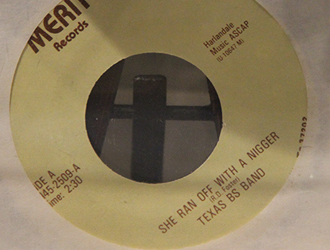
White supremacists have found the Internet an indispensable tool for spreading their message of detest. An Internet search of nigger locates many anti-black web pages: Niggers Must Die, Hang A Nigger For America, Nigger Joke Central, and literally thousands of others. Visitors to these sites know, like most blacks know experientially, that nigger is an expression of anti-black antipathy. Is it surprising that nigger is the almost commonly used racist slur during hate crimes?
No American minority group has been caricatured as ofttimes, in every bit many ways, as take blacks. These caricatures combined distorted physical descriptions and negative cultural and behavior stereotypes. The Coon caricature, for case, was a tall, skinny, loose-jointed, dark-skinned male, often bald, with oversized, ruby-red lips. His habiliment was either ragged and dirty or outlandishly gaudy. His slow, exaggerated gait suggested laziness. He was a pauper, lacking ambition and the skills necessary for upwardly social mobility. He was a buffoon. When frightened, the Coon's optics bulged and darted. His voice communication was slurred, halted, and replete with malapropisms. His shrill, high-pitched voice made whites laugh. The Coon caricature dehumanized blacks, and served as a justification for social, economic, and political bigotry.
Nigger may be viewed as an umbrella term - a way of saying that blacks have the negative characteristics of the Coon, Buck, Tom, Mammy, Sambo, Picaninny, and other anti-black caricatures. Nigger, like the caricatures it encompasses and implies, belittles blacks, and rationalizes their mistreatment. The use of the word or its variants past blacks has non significantly lessened its sting. This is not surprising. The historical relationship between European Americans and African Americans was shaped past a racial hierarchy which spanned 3 centuries. Anti-black attitudes, values, and behavior were normative. Historically, nigger more than any word captured the personal contempt and institutionalized racism directed toward blacks. Information technology still does.
© Dr. David Pilgrim, Professor of Sociology, and Dr. Phillip Middleton, Professor of Languages and Literature,
Ferris State Academy.
Sept., 2001
Edited 2012
1 An before version of this paper, entitled "Purposeful Venom Revisited," was published in Matthews (1999, pp. 91-93). David Pilgrim is a sociologist; Phillip Middleton is a linguist.
2 Dictionaries typically divers nigger as a synonym for Negro, Black, or dark-skinned people. Meet, for example, Wentworth (1944, p. 412). Recent dictionaries are more likely to mention that nigger is a term of antipathy. Please read Williams (2001).
three Even innocent words - boy, girl, and uncle - took on racist meanings when applied to blacks.
iv For a brief analysis of these terms come across, Simpson (1989, pp. 401-405).
References
Allen-Taylor, J. D. (1998, April 9-15). New word order. Metro. Retrieved from http://www.metroactive.com/papers/metro/04.09.98/cover/nigger-9814.html.
Baraka, A. (1969). Black magic: Sabotage, Target study, Black art: Nerveless poetry, 1961-1967. 1969. New York, NY: Bobbs-Merrill.
Bender, L. (Producer), & Tarantino, Q. (Manager). (1994). Pulp fiction [Movement picture]. United states of america: Miramax Films.
Bender, L. (Producer), & Tarantino, Q. (Director) (1997). Jackie Dark-brown [Motility picture show]. Us: Miramax Films.
Christie, A. (1982). Ten little niggers. Glasgow: Collins.
Driver, J. (2001, June 11). Black comedy's reactionary hipness: The mirth of a nation. The New Republic, 224, 29-33.
Ehrlich, H J. (1973). The social psychology of prejudice: A systematic theoretical review and propositional inventory of the American social psychological study of prejudice. New York, NY: Wiley.
Light-green, J. (1984). The lexicon of contemporary slang. New York, NY: Stein and Twenty-four hour period.
Henderson, S. E. (1972). Understanding the new Black verse: Black oral communication and Blackness music as poetic references. New York, NY: William Morrow and Company.
Jolly Jingles. (due north.d.). Chicago, IL: M.A. Donohue & Company. Matthews, G. Eastward. (Ed.) (1999). Journey towards nationalism: The implications of race and racism. New York, NY: Forbes.
Newmyer, R. F., & Silverish, J. (Producers), & Fuqua, A. (Director). (2001). Training solar day [Motion picture]. United states: Warner Bros. Pictures.
Palmore, E. (1962, January). Ethnophaulisms and ethnocentrism. American Journal of Sociology 67, 442-445.
Schaefer, R. T. (2000). Racial and ethnic groups (8th ed.). Upper Saddle River, NJ: Prentice Hall.
Shakur, T. (1991). Kleptomaniacal ass nigga. Retrieved from http://lyrics.wikia.com/2Pac:Crooked_Ass_Nigga.
Simpson, J. A., & Weiner, E. Southward. C. (1989). The Oxford English dictionary. (2nd ed.). Oxford: Oxford Academy Press.
Wentworth, H. (1944). American dialect lexicon. New York, NY: Thomas Y. Crowell Co.
Williams, C. M. (2001). Nigger. In Kim Pearson's dictionary of slurs. Retrieved from http://web.archive.org/web/20090223185954/http://kpearson.faculty.tcnj.edu/Dictionary/nigger.htm.
pictonfrinslazince.blogspot.com
Source: https://www.ferris.edu/HTMLS/news/jimcrow/caricature/homepage.htm